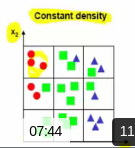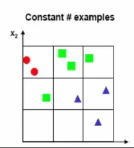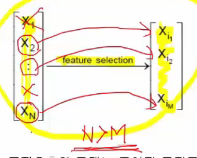================================================================================
* PCA: technique which reduces dimensionality of feature vector
================================================================================
* Curse of dimensionality:
various problems as dimension goes higher in multivariate analysis
================================================================================
* Example
* pattern recognition problem with 3 classes
* method:
- divide "feature space" into same sized 3 bins
- count samples which are involved each bins
- when unknown data is given, you classify that data into dominated bin's class
(k-NNR driven Bayes classifier)
================================================================================
* Example
* 3 classes
* feature vector is 1 dimension
 * 1st bin : red dominant
* 2nd bin : green dominant
* 3rd bin : blue dominant
* When you use 1D feature vector, if you divide 1 dimension axis into 3 bins,
you can see classes are overlapped in too many places
================================================================================
You can use 2D feature vector $$$x=[x_1, x_2]$$$
When you use 2D feature vector,
"feature space" becomes 2D, number of bin increases up to 9 bins (3*3)
* 1st bin : red dominant
* 2nd bin : green dominant
* 3rd bin : blue dominant
* When you use 1D feature vector, if you divide 1 dimension axis into 3 bins,
you can see classes are overlapped in too many places
================================================================================
You can use 2D feature vector $$$x=[x_1, x_2]$$$
When you use 2D feature vector,
"feature space" becomes 2D, number of bin increases up to 9 bins (3*3)
 ================================================================================
You should choose either "constant density" or "constant number of example"
* Constant density :
================================================================================
You should choose either "constant density" or "constant number of example"
* Constant density :
 * Each bin should have same or similar data
3 3 3
3 3 2
3 3 3
================================================================================
* constant number of example :
* Each bin should have same or similar data
3 3 3
3 3 2
3 3 3
================================================================================
* constant number of example :
 2 2 1
1 1 1
0 0 1
* Meaning
- If you have 0 data in some bins, there is no prob and statistical ways you can use
================================================================================
* You can use 3D feature vector, $$$x=[x_1,x_2,x_3]$$$
2 2 1
1 1 1
0 0 1
* Meaning
- If you have 0 data in some bins, there is no prob and statistical ways you can use
================================================================================
* You can use 3D feature vector, $$$x=[x_1,x_2,x_3]$$$
 * Number of bins: $$$27=3^{3}$$$
* constant density:
81=3*27 samples are required
* constant number of example:
* 9 data bin out of 81 bins
* bin which has 1 data has no meaning
* Sparse feature space problem
================================================================================
Issues of high dimensionality of feature vector
* "Low performance of classification" due to "noise features"
* "Slow" training and recognition speed
* Needs more huge data for training for high dimensional feature vector
================================================================================
* Curse of the dimensionality
* Number of bins: $$$27=3^{3}$$$
* constant density:
81=3*27 samples are required
* constant number of example:
* 9 data bin out of 81 bins
* bin which has 1 data has no meaning
* Sparse feature space problem
================================================================================
Issues of high dimensionality of feature vector
* "Low performance of classification" due to "noise features"
* "Slow" training and recognition speed
* Needs more huge data for training for high dimensional feature vector
================================================================================
* Curse of the dimensionality
 ================================================================================
Solution for curse of the dimensionality
* Use prior knowledge and domain knowledge
* Increase smoothness of target function (or hypothesis function)
* Reduce dimensionality of feature vector
================================================================================
* How to reduce dimensionality of feature vector
- Feature selection
- Feature extraction
================================================================================
* Feature selection :
================================================================================
Solution for curse of the dimensionality
* Use prior knowledge and domain knowledge
* Increase smoothness of target function (or hypothesis function)
* Reduce dimensionality of feature vector
================================================================================
* How to reduce dimensionality of feature vector
- Feature selection
- Feature extraction
================================================================================
* Feature selection :
 * You select "partial features" from original feature vector
* This is not much useful
================================================================================
* Feature extraction :
* You select "partial features" from original feature vector
* This is not much useful
================================================================================
* Feature extraction :
 * Code
original_feature_vector=[x_1,x_2,...,x_N]
extracted_feature_vector=feature_extraction_func(original_feature_vector)
print(extracted_feature_vector)
$$$[y_1,y_2,...,y_M]$$$
* Most information of original feature vector should be kept
* feature_extraction_func = non-linear function or linear function (this is much used)
================================================================================
* Linear transformation
$$$y=Wx$$$
$$$x$$$: original vector
$$$y$$$: transformed vector
$$$W$$$: transformation matrix
================================================================================
You can use PCA to find W
* Code
original_feature_vector=[x_1,x_2,...,x_N]
extracted_feature_vector=feature_extraction_func(original_feature_vector)
print(extracted_feature_vector)
$$$[y_1,y_2,...,y_M]$$$
* Most information of original feature vector should be kept
* feature_extraction_func = non-linear function or linear function (this is much used)
================================================================================
* Linear transformation
$$$y=Wx$$$
$$$x$$$: original vector
$$$y$$$: transformed vector
$$$W$$$: transformation matrix
================================================================================
You can use PCA to find W







